

Alternative Energies.
Coal. Hydropower. Tar Sands and Shale Gas. Nuclear. Net energy (Ten fundamental principles of) Introduction EROI is a tool of net energy analysis, a methodology that seeks to compare the amount of energy delivered to society by a technology to the total energy required to find, extract, process, deliver, and otherwise upgrade that energy to a socially useful form.

Net energy analysis was developed in response to the emergence of energy as an important economic, technological and geopolitical force following the energy price increases of 1973-74 and 1980-81. Interest in net energy analysis was rekindled in recent years following another round of energy price increases, growing concern about energy's role in climate change, and the debate surrounding the remaining lifetime of conventional fossil fuels, especially crude oil.
The principles 1. The efficiency and effectiveness of energy capture is a central organizing principle in ecology. 2. 3. One aspect of energy quality: a comparison of the energy content per unit mass and per unit volume for various sources. 4. 5. 7. 8. 9. 10. Energy quality. Introduction.
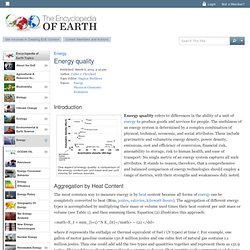
Energy Export Databrowser. Energy flow chart. Energy Flow. Energy transitions past and future. Introduction In Greek mythology, Prometheus defied the will of Zeus by stealing fire and giving it to the mortal race of men in their dark caves.
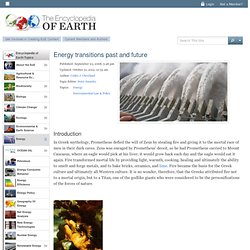
Zeus was enraged by Prometheus' deceit, so he had Prometheus carried to Mount Caucasus, where an eagle would pick at his liver; it would grow back each day and the eagle would eat it again. Fire transformed mortal life by providing light, warmth, cooking, healing and ultimately the ability to smelt and forge metals, and to bake bricks, ceramics, and lime. Fire became the basis for the Greek culture and ultimately all Western culture. America's Energy Future: Technology and Transformation. Overview Authors Committee on America's Energy Future; National Academy of Sciences; National Academy of Engineering; National Research Council Description For multi-user PDF licensing, please contact customer service. Energy touches our lives in countless ways and its costs are felt when we fill up at the gas pump, pay our home heating bills, and keep businesses both large and small running.
Energy touches our lives in countless ways and its costs are felt when we fill up at the gas pump, pay our home heating bills, and keep businesses both large and small running. [read less] Suggested Citation National Research Council. Import this citation to: Olduvai Theory: Sliding Towards a Post-Industrial Stone Age, by Richard Duncan. Why is the global economy constrained by the energy cost of energy?
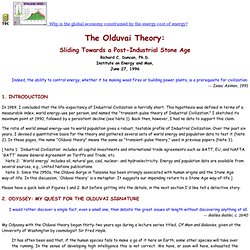
Indeed, the ability to control energy, whether it be making wood fires or building power plants, is a prerequisite for civilization. -- Isaac Asimov, 1991 In 1989, I concluded that the life-expectancy of Industrial Civilization is horridly short. This hypothesis was defined in terms of a measurable index, world energy-use per person, and named the "transient-pulse theory of Industrial Civilization. " I sketched its maximum point at 1990, followed by a persistent decline (see Note 1). Back then, however, I had no data to support this claim. The Social Contract - The Olduvai Theory - Toward Re-Equalizing the World Standard of Living. By Richard Duncan Volume 19, Number 4 (Summer 2009) Issue theme: "Progressives for Immigration Reform" Introduction The Olduvai Theory is defined by the rise and fall of the World standard of living.
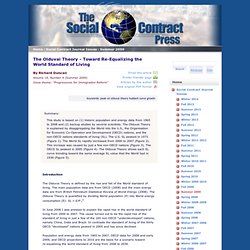
The main population data are from OECD (2008) and the main energy data are from British Petroleum Statistical Review of World Energy (2008). The Olduvai Theory is quantified by dividing World population (P) into World energy consumption (E): SL = E/P .1 In June 2008 I was pressed to explain the rapid rise in the world standard of living from 2000 to 2007. Population and energy data from 1965 to 2007, OECD data for 2008 and early 2009, and OECD projections to 2010 are the basis for a scenario toward re-equalizing the world standard of living from 2008 to 2030.
The following backup studies are referenced, quoted, and discussed below: M. Jay W. Three Geo/STEP Scientists. Revisiting the Olduvai Theory. At first Richard Duncan probably wasn't aware of Peak Oil, but by the nineties, working with Walter Youngquist, he began to include it, and refined the post-peak period into three phases: 1.
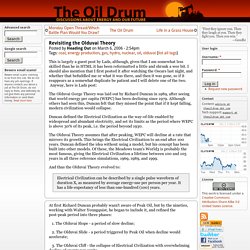
The Olduvai Slope - a period of slow decline; 2. The Olduvai Slide - a period triggered by Peak Oil when decline would accelerate; 3. The Olduvai Theory Pulse. Electric Civilization endures for no more than 100 years, between 1930 and 2030. You can get a better insight of the Olduvai Gorge Theory in these papers available at Jay Hanson's dieoff.org site: Energy from Fossil Fuels (historical) Originally Published As: Title: Energy from Fossil Fuels Author: M.
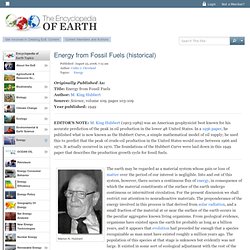
King Hubbert Source: Science, volume 109, pages 103-109 Year published: 1949 Marion K. Hubbert The earth may be regarded as a material system whose gain or loss of matter over the period of our interest is negligible.